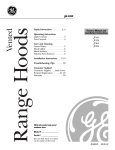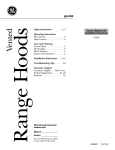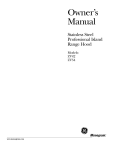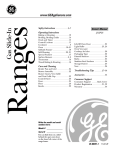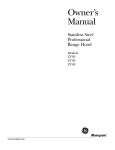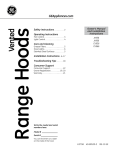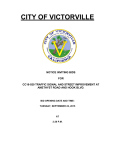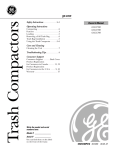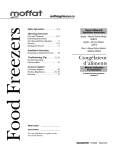Download GE CV936 User's Manual
Transcript
Vented Range Hoods www.GEAppliances.ca Safety Instructions . . . . . . . . . 2, 3 Operating Instructions Light Controls . . . . . . . . . . . . . . . .4 Vent Controls . . . . . . . . . . . . . . . .4 Owner’s Manual and Installation Instructions JV936 CV936 Care and Cleaning Grease Filters . . . . . . . . . . . . . . . .5 Hood Lights . . . . . . . . . . . . . . . . .6 Hood Surfaces . . . . . . . . . . . . . . . .5 Stainless Steel Surfaces . . . . . . . . .5 Installation Instructions . . .7–18 Troubleshooting Tips . . . . . . . .20 Consumer Support Consumer Support . . . Back Cover Product Registration . . . . . .21, 22 Warranty . . . . . . . . . . . . . . . . . . . 23 Write the model and serial numbers here: Model # ________________ Serial # ________________ You can find them on a label on the inside of the hood. 350A4502P550 08-07 ATS SAFETY PRECAUTIONS WARNING – TO REDUCE THE RISK OF FIRE, WARNING – TO REDUCE THE RISK OF ELECTRIC SHOCK OR INJURY TO PERSONS, OBSERVE THE FOLLOWING: A. Use this unit only in the manner intended by the manufacturer. If you have questions, contact the manufacturer. B. Before servicing or cleaning unit, switch power off at service panel and lock the service disconnecting means to prevent power from being switched on accidentally. When the service disconnecting means cannot be locked, securely fasten a prominent warning device, such as a tag, to the service panel. C. Do not use this unit with any solid-state speed control device. D. This unit must be grounded. Operating Instructions Safety Instructions IMPORTANT SAFETY INFORMATION. READ ALL INSTRUCTIONS BEFORE USING. Care and Cleaning CAUTION – For general ventilating use only. Do not use to exhaust hazardous or explosive materials and vapors. CAUTION – To reduce risk of fire and to Consumer Support Troubleshooting Tips properly exhaust air, be sure to duct air outside. Do not vent exhaust air into spaces within walls or ceilings or into attics, crawl spaces, or garages. 2 INJURY TO PERSONS IN THE EVENT OF A RANGE TOP GREASE FIRE, OBSERVE THE FOLLOWING*: A. SMOTHER FLAMES with a close-fitting lid, cookie sheet, or metal tray, then turn off the burner. BE CAREFUL TO PREVENT BURNS. If the flames do not go out immediately, EVACUATE AND CALL THE FIRE DEPARTMENT. B. NEVER PICK UP A FLAMING PAN— You may be burned. C. DO NOT USE WATER, including wet dishcloths or towels—a violent steam explosion will result. D. Use an extinguisher ONLY if: 1. You know you have a Class ABC extinguisher, and you already know how to operate it. 2. The fire is small and contained in the area where it started. 3. The fire department is being called. 4. You can fight the fire with your back to an exit. * Based on “Kitchen Fire Safety Tips” published by NFPA. SAFETY PRECAUTIONS WARNING – TO REDUCE THE RISK OF WARNING – TO REDUCE THE RISK OF FIRE, USE ONLY METAL DUCTWORK. ■ Do not attempt to repair or replace any part of your hood unless it is specifically recommended in this guide. All other servicing should be referred to a qualified technician. WARNING – TO REDUCE THE RISK OF FIRE, Care and Cleaning ELECTRIC SHOCK OR INJURY TO PERSONS, OBSERVE THE FOLLOWING: A. Installation work and electrical wiring must be done by qualified person(s) in accordance with all applicable codes and standards, including fire-rated construction. B. Sufficient air is needed for proper combustion and exhausting of gases through the flue (chimney) of fuel burning equipment to prevent back drafting. Follow the heating equipment manufacturer’s guideline and safety standards such as those published by the National Fire Protection Association (NFPA), and the American Society for Heating, Refrigeration and Air Conditioning Engineers (ASHRAE), and the local code authorities. C. When cutting or drilling into wall or ceiling, do not damage electrical wiring and other hidden utilities. D. Ducted fans must always be vented to the outdoors. Operating Instructions A RANGE TOP GREASE FIRE: A. Never leave surface units unattended at high settings. Boilovers cause smoking and greasy spillovers that may ignite. Heat oils slowly on low or medium settings. B. Always turn hood ON when cooking at high heat or when cooking flaming foods. C. Clean ventilating fans frequently. Grease should not be allowed to accumulate on fan or filter. D. Use proper pan size. Always use cookware appropriate for the size of the surface element. Safety Instructions www.GEAppliances.ca Troubleshooting Tips Consumer Support READ AND FOLLOW THIS SAFETY INFORMATION CAREFULLY. READ AND SAVE THESE INSTRUCTIONS 3 Throughout this manual, features and appearance may vary from your model. Operating Instructions Safety Instructions Using the hood controls. FAN Control LIGHT Control Turn the FAN speed control to LO, MED LO, MED HI or HI, as needed. Turn the LIGHT control to HI for bright light while cooking. Turn to NITE for use as a night light. Care and Cleaning Continuous use of the fan system while cooking helps keep the kitchen comfortable and less humid. It also reduces cooking odors and soiling moisture that create a frequent need for cleaning. Consumer Support Troubleshooting Tips NOTE: When the fan is operating on the LO setting, it will be very quiet. Always make sure that the fan is turned OFF when you are finished in the kitchen. 4 www.GEAppliances.ca Be sure electrical power is off and all surfaces are cool before cleaning or servicing any part of the vent hood. Reusable Metal Grease Filters The hood has 2 metal reusable grease filters. If it ever becomes necessary to replace the metal grease filters, they may be ordered from your GE supplier. Heavy-duty commercial filters may also be used in place of the filters. For 36” (91.4 cm) hoods, order Kit no. JXBF36SS. To order, call 1.800.661.1616 Place the top end of the filter against the inside front of the hood. For this reason, the filters must ALWAYS be in place when the hood is used. The grease filters should be cleaned once a month, or as needed. Slide it up until it stops and push the bottom end back until it snaps into place. To clean the grease filters, soak them and then swish them around in hot water and detergent. Don’t use ammonia or ammonia products because they will darken the metal. Do not use abrasives or oven cleaners. Light brushing can be used to remove embedded dirt. Rinse, shake and let them dry before replacing. They may also be cleaned in an automatic dishwasher. Care and Cleaning For 30” (76.2 cm) hoods, order Kit no. JXBF30SS. To replace: Hold the filter at the bottom with the handle. Operating Instructions The metal filters trap grease released by foods on the cooktop. They also help prevent flaming foods on the cooktop from damaging the inside of the hood. To remove: Grasp the filter handle and pull it up, forward and out. Safety Instructions Care and cleaning of the vent hood. Painted Surfaces (on some models) To order: To order CERAMA BRYTE® Stainless Steel Cleaning Polish and Conditioner, please call our toll-free number: www.GEAppliances.ca CERAMA BRYTE® Stainless Steel Cleaning Polish and Conditioner . . . # PM10X313 Stainless Steel Surfaces (on some models) Do not use a steel-wool pad; it will scratch the surface. Shake bottle well. Place a small amount of CERAMA BRYTE® Stainless Steel Cleaning Polish and Conditioner on a dry cloth or dry paper towel. Clean a small area (approximately 8” x 8” or 20.3 x 20.3 cm), rubbing with the grain of the stainless steel if applicable. Consumer Support National Parts Center . . . . . . . . . . . 1.800.661.1616 Do not use steel-wool pads or other abrasive cleaners. They will scratch the surface. Troubleshooting Tips To clean the hood surface, use a hot, damp cloth with a mild detergent suitable for painted surfaces. Use a clean, hot, damp cloth to remove soap. Dry with a dry, clean cloth. Dry and buff with a clean, dry paper towel or soft cloth. Repeat as necessary. 5 Be sure electrical power is off and all surfaces are cool before cleaning or servicing any part of the vent hood. Receptacle Socket Hood Lights NOTE: The glass cover should be removed only when cold. Wearing latex gloves may offer a better grip. Receptacle CAUTION: Before replacing your Operating Instructions Safety Instructions Care and cleaning of the vent hood. Bulb Glass cover light bulb, disconnect the electrical power to the hood at the main fuse or circuit breaker panel. Be sure to let the light cover and bulb cool completely. For your safety, do not touch a hot bulb with bare hands or a damp cloth. Push the bulb straight into the receptacle all the way. To remove: Turn the glass cover counterclockwise until the glass cover clears the socket. Place the glass cover onto the socket and turn clockwise until secure. Care and Cleaning Using gloves or a dry cloth, remove the bulb by pulling it straight out. To replace: Use a new 12-volt, 20-watt (maximum) Halogen bulb for a G-4 base. Using gloves or a dry cloth, remove the new bulb from its packaging. Consumer Support Troubleshooting Tips NOTE: Do not touch the new halogen bulb with bare fingers. Touching the bulb with bare fingers will significantly reduce the life of the bulb. 6 Use gloves or cloth For improved lighting, clean the glass cover frequently using a damp cloth. This should be done when the hood is completely cool. Reconnect electrical power to the hood. Installation Instructions Range Hood Questions? Call 1-800-561-3344 or Visit our Website at: www.GEAppliances.ca BEFORE YOU BEGIN PRODUCT DIMENSIONS Read these instructions completely and carefully. • 12" IMPORTANT – Save these instructions for local inspector’s use. • • • • • • • IMPORTANT – Observe all governing codes and ordinances. Note to Installer – Be sure to leave these instructions with the Consumer. Note to Consumer – Keep these instructions for future reference. Skill level – Installation of this vent hood requires basic mechanical and electrical skills. Completion time – 1 to 3 hours Proper installation is the responsibility of the installer. Product failure due to improper installation is not covered under the Warranty. 18" 21" 29-7/8" 30” Models Requires a 30” Wide Opening 12" CAUTION: 18" Due to the weight and size of these vent hoods and to reduce the risk of personal injury or damage to the product, TWO PEOPLE ARE REQUIRED FOR PROPER INSTALLATION. 21" FOR YOUR SAFETY: 36” Models Requires a 36” Wide Opening WARNING – Before beginning the installation, switch power off at service panel and lock the service disconnecting means to prevent power from being switched on accidentally. When the service disconnecting means cannot be locked, securely fasten a prominent warning device, such as a tag, to the service panel. 1 Ft = 0.3 m 1” = 2.5 cm 7 35-7/8" Installation Instructions INSTALLATION CLEARANCES OPTIONAL ACCESSORIES These vent hoods are designed to be installed onto a wall. They may be installed beneath a soffit or cabinet. • Install these hoods 24” Min. to 36” Max above the cooking surface. Duct Cover A Decorative duct cover is available to accommodate 8 to 10 ft. ceiling heights. The duct cover will expand from 12” Min. or 24” to 34” Max. height. • The duct cover conceals the ductwork running from the top of the hood to the ceiling. • The duct cover accessory fits both 30” and 36” wide models. Order the duct cover accessory at the same time as the vent hood. All accessories should be on site at the time of hood installation. SOFFIT INSTALLATION SOFFIT Order the correct color to match your model: JXCHBB - Black, JXCHWW - White, JXCHCC - Bisque, JXCHSS - Stainless Steel. 24" MIN. 36" MAX. Ceiling Bracket In this installation the ductwork running from the top of the hood will be concealed in the soffit or upper cabinetry. WALL MOUNT INSTALLATION 2 Wood Screws 2 Washers 2 Wall Fasteners 4 Phillips Head Screws 24" MIN. 36" MAX. 2-Piece Duct Cover With Ceiling Bracket 2 Phillips Head Decorative Screws For this installation, a decorative duct cover is available to conceal the ductwork running from the top of the hood. Use of the duct cover requires special consideration to the installation height above the countertop. See page 12 for details. Commercial Filter Kit Use this kit to replace supplied filters. JXBF30SS, Commercial Filter Kit for 30” wide models. JXBF36SS, Commercial Filter Kit for 36” wide models. Includes 2 commercial filters and 2 drip trays. 1 Ft = 0.3 m 1” = 2.5 cm 2 Baffle Filters 2 Drip Trays 8 Installation Instructions ADVANCE PLANNING DECORATIVE DUCT COVERS Ductwork Planning • This hood may be vented vertically through upper cabinets, soffit or ceiling. A duct transition piece is supplied for vertical exhaust. Use locally supplied elbows to vent horizontally through the rear wall. See page 13. • Determine the exact location of the vent hood. • Use the shortest and straightest duct route possible. For satisfactory performance, duct run should not exceed 100 equivalent length for any duct configurations. • Refer to “Duct Fittings” chart to compute the maximum permissible length for duct runs to the outdoors. • Use metal ductwork only. • A transition piece for 7” round duct is supplied. Use 7” round duct or you may use 3¼” x 12” rectangular. • Install a wall cap or roof cap with damper at the exterior opening. Order the wall or roof cap and any transition needed in advance. A decorative duct cover is available to fit both model widths. The duct cover conceals the ductwork running from the top of the hood to the ceiling or soffit. The duct cover will fit 8 ft. to 10 ft. ceiling heights. See page 12 for details. POWER SUPPLY IMPORTANT - (Please read carefully) WARNING: FOR PERSONAL SAFETY, THIS APPLIANCE MUST BE PROPERLY GROUNDED. Remove house fuse or open circuit breaker before beginning installation. Do not use an extension cord or adapter plug with this appliance. Follow National electrical codes or prevailing local codes and ordinances. Kit - JXDW1 Order kit JXDW1 if your installation requires horizontal ducting from the top of the hood through the back wall and: • You have an 8 ft. ceiling and need to use a JXCH Series Chimney Cover, or • You have a 12” cabinet or 12” soffit that the hood is to be mounted beneath. This kit provides a duct transition from 7” round to 3¼” x 10” rectangular for through-the-wall venting. Electrical supply This vent hood must be supplied with 120V, 60Hz, and connected to an individual, properly grounded branch circuit, and protected by a 15 or 20 amp circuit breaker or time delay fuse. • Wiring must be 2 wire with ground. • If the electrical supply does not meet the above requirements, call a licensed electrician before proceeding. • Route house wiring as close to the installation location as possible in the ceiling, soffit or wall. See page 13 for details. • Connect the wiring to the house wiring in accordance with local codes. Wall Framing for Adequate Support • This vent hood is heavy. Adequate structural support must be provided. The hood must be secured to vertical studs in the wall. See page 14. • We strongly recommend that the vent hood with duct cover be on site before final framing and wall finishing. This will also help to accurately locate the ductwork and electrical service. Grounding instructions Follow these guidelines for proper duct sizing in the ducting charts. WARNING: Air Volume in CFM DUCT FITTINGS The grounding conductor must be connected to a ground metal, permanent wiring system, or an equipment-grounding terminal or lead on the hood. DUCTING CHART - 30” and 36” Models Equivalent Length in Feet for 7” Round Duct 0 25 75 100 125 50 600 The improper connection of the equipment-grounding conductor can result in a risk of electric shock. Check with a qualified electrician or service representative if you are in doubt whether the appliance is properly grounded. 150 500 400 1 Ft = 0.3 m 1” = 2.5 cm 300 200 7” Round 90° Elbow = 8 ft. 7” Roof Cap = 30 ft. MAXIMUM DUCT LENGTH: 7” dia. duct, should not exceed 100 equivalent feet. 9 Installation Instructions DUCT FITTINGS Use this chart to compute maximum permissable lengths for duct runs to outdoors. Note: Do not exceed maximum permissable equivalent lengths! Maximum duct length: 100 foot for vent hoods. Flexible ducting: If flexible metal ducting is used, all the equivalent feet values in the table should be doubled. The flexible metal duct should be straight and smooth and extended as much as possible. Duct Piece Dimensions Equivalent Length* Round, straight 1 ft. (per foot length 3¼” x 12” straight 1 ft. (per foot length 90° elbow 8 ft. 45° elbow 6 ft. 3¼” x 12” or 90° elbow 15 ft. 3¼” x 12” or 45° elbow 9 ft. 3¼” x 12” or 90° flat elbow 20 ft. 7” round to 3¼” x 12” transition 1 ft. 3¼” x 12” to 7” round transition 5 ft. 7” round to 3¼” x 12” transition 90° elbow 5 ft. 3¼” x 12” to7” round transition 90° elbow 15 ft. Round wall cap with damper 30 ft. 3¼” x 12” wall cap with damper 30 ft. 7” round roof cap 30 ft. Round roof vent 24 ft. Quantity Used Do NOT use flexible ducting. Note: Any home ventilation system, such as a ventilation hood, may interrupt the proper flow of combustion air and exhaust required by fireplaces, gas furnaces, gas water heaters and other naturally vented systems. To minimize the chance of interruption of such naturally vented systems, follow the heating equipment manufacturer’s guidelines and safety standards such as those published by NFPA and ASHRAE. This Hood Must Use 7” Round Duct. It Can Transition To 3¼” x 12” Duct Kit - JXDW1 Order kit JXDW1 if your installation requires horizontal ducting from the top of the hood through the backwall and: • You have an 8 ft. ceiling and need to use a JXCH Series Chimney Cover, or • You have a 12” cabinet or 12” soffit that the hood is to be mounted beneath. This kit provides a duct transition from 7” round to 3¼” x 10” rectangular for through-the-wall venting. Using a smaller diameter duct size will reduce performance 1 Ft = 0.3 m 1” = 2.5 cm *Actual length of straight duct plus duct fitting equivalent. Equivalent length of duct pieces are based on actual tests conducted by GE Evaluation Engineering and reflect requirements for good venting performance with any ventilation hood. 10 Total Duct Run Total Equivalent Length Installation Instructions TOOLS AND MATERIALS REQUIRED REMOVE THE PACKAGING (NOT SUPPLIED) • Remove parts package from the “V” shaped cardboard insert. Remove insert. Remove shipping pads. • Lift the hood out of the box. CAUTION: Lift hood by grasping the outside edges of the exhaust opening on the top. Do not lift hood by the exhaust opening divider – damage will occur. Pencil and tape measure Duct tape Phillips and Flat blade screwdrivers Parts Package Wood Mounting Support Duct Transition Hood ¼” pivoting hex socket Electric drill with 1/8” and 3/8” bits Motor Mounted on Skid Safety glasses Spirit level Shipping Carton • Remove transition duct piece from the inside of the hood. Discard screws. • The vent hood motor is shipped secured to the skid with 4 screws. Locate and remove 2 screws on each side of the motor. Discard the shipping skid. Flashlight cUL Listed Wire nuts Hold Down Screws Pliers Hammer Metal snips Wire Cutter/Stripper Hold Down Screws Saber saw or Key Hole Saw Ladder • From the inside of the hood, remove shipping screws holding the wood mounting piece to the back side of the hood. Set aside wood mounting piece and screws for later installation. Do not discard. • Remove junction box cover and knockout. • Install strain relief onto back or top of hood. • Remove all tape and packing material from the hood, duct transition and motor. Allen Wrench Additional Materials: • 120V 60Hz. 15 or 20 Amp, 2 wire with ground. Properly grounded branch circuit. • Strain relief for junction box. • 7” round metal duct or 3¼” x 12” rectangular duct, length to suit installation. 1 Ft = 0.3 m 1” = 2.5 cm 11 Installation Instructions PARTS PROVIDED Locate the hardware accessory box packed with the hood and check contents. Screws, wall fasteners, washers Filter Support Duct Transition with Damper 2 Aluminum Grease Filters 2 Control Knobs DUCT COVER REQUIREMENTS Review the following examples to ensure a trouble free installation using the duct cover accessory. We recommend that the vent hood and decorative duct cover (if used) be on site before final framing and wall finishing. This will help to accurately locate studs, ductwork and electrical service. Read these instructions to determine if the duct cover accessory can be used for your installation situation. 8 ft. Ceiling 8 ft. ceilings: The hood must be installed at 30” above the cooking surface (or 66” above the floor). The duct cover willnot fit if the hood is installed at a lower or higher height. Use the outside 12” section, discard the inside section. Duct Cover Accessory: • Use the decorative duct cover to conceal duct work running from the top of the hood to the ceiling. • The duct cover accessory consists of 2 pieces. The outside piece is 12” high, the inside piece is 22”. 22" Nested together they are 24” min., expanding to a total maximum height of 34”. • The outside piece can be used alone to fill a 12” height. • For heights over 12”, the ceiling bracket must be installed to secure the cover at the top. 12" 30" 9 ft. Ceiling 12" 24" 30" 12" 30" 24" 11" 12" 9 ft. ceilings: Install the hood 24” min. and up to a maximum of 30” above the cooking surface. The duct cover will expand to reach ceiling height. 10 ft. Ceiling 30" 34" To avoid unsightly gaps, plan the hood installation height for duct cover use. • The cover will fit a 12” min. height from the top of the hood to the ceiling, – or 24” min. and expanding up to 34” from the top of the hood to the ceiling. THE DUCT COVER CANNOT BE USED WHEN THE DISTANCE ABOVE THE TOP OF THE HOOD IS BETWEEN 12” AND 24”. 32" 36" Max. 10 ft. ceilings: nstall the hood 32” min. to 36” max. above the cooking surface. The duct cover will expand to a maximum of 34” above the top of the hood to meet the ceiling. 1 Ft = 0.3 m 1” = 2.5 cm 12 Installation Instructions DETERMINE HOOD, DUCTWORK AND WIRING LOCATIONS • Measure desired distance from the bottom of the hood to the cooking surface, 24” min. to 36” max. Refer to the previous page if the accessory duct cover will be used. • Use a level to draw a horizontal line indicating the bottom of the hood. • Use a level to draw the cooktop centerline location. • Measure 15-3/8” up from the horizontal line for the bottom of the hood. Draw another horizontal line. • Measure 18” up from the line for the bottom of the hood, draw another horizontal line to indicate the top of the hood. FOR CEILING VENT DUCTING 6-7/8” Centerline To Wall Electrical 7½” Dia. Hole FOR WALL VENT DUCT Centerline 8” Min. above Top of Hood Top of Hood FOR VERTICAL (Straight Up) DUCTING: • If venting out the ceiling, extend the centerline forward on the ceiling. – Measure 6-7/8” from drywall to mark centerline for a 7½” dia. duct hole on the ceiling. – If drywall is not present, add drywall thickness to the 6-7/8” dimension. 18" Bottom of Hood Venting through a soffit or upper cabinet. • Follow the same procedure for ceiling ducting to cut the 7½” dia. hole through the top of the cabinet or soffit. • See Step 4, page 5 for details to cut opening for duct transition. Wood Support 15-3/8" Electrical FOR DUCTING THROUGH REAR WALL: • Measure the supplied duct transition with any straight run length of duct used, plus 90° elbow height. Draw a horizontal line on the wall intersecting the centerline. House Wiring Location: 14-1/8” for 36” Models 11-1/8” for 30” Models • The junction box is fastened to the back of the hood on the right side. See illustrations for hood knockout locations. Note: The junction box can be relocated to the inside top of the hood. House wiring may enter the junction box from the rear or the top of the hood at the right side. To route house wiring through the ceiling or soffit; – Cut a hole approximately 1” dia., 5-7/8” forward on the ceiling, 11-1/8” to the right of the centerline for 30” models or, 14-1/8” to the right of the centerline for 36” models. To route house wiring through the wall, – Cut a hole approximately 1” dia., 10-1/16” down from the top of the hood, 11-1/8” to the right of the centerline for 30” models or, 14-1/8” to the right of the centerline for 36” models. • Remove top or rear knockout depending on your installation. 5-7/8" Knockout Locations 10-1/16" 14-1/8” for 36” Models 11-1/8” for 30” Models 1 Ft = 0.3 m 1” = 2.5 cm 13 Installation Instructions 1 INSTALL HOOD SUPPORT 2 INSTALL TRANSITION • Locate at least 2 vertical studs at the wood mounting location by tapping drywall with a hammer or use a stud finder. • Center the supplied wood horizontal support, left to right and below the marked line. Top of Hood Duct Transition 7” Min. Opening for Ductwork • Place the transition piece over the hood exhaust. Secure transition to hood with 4 screws provided. • Use duct tape to seal the connection. 3 INSTALL HOOD ONTO WALL Wood Support 15-3/8" Remove Shipping Tape on Damper IMPORTANT: Remove shipping tape from damper and check that damper moves freely. IMPORTANT: Framing must be capable of supporting 100 lbs (45.3 kg) • Lift the hood and place over the wood support. The top keyhole slots in the hood should engage the protruding mounting screws. Allow the hood to slide down into position. • Pull house wiring through knockout at the rear or the top of the hood. • Check to be sure the hood is level and centered. The arrow shaped cutout in the back of the hood allows viewing the marked centerline. • Remove cover from junction box. 24" to 36" Centerline of Installation space • Drill 1/8” pilot holes through the support, drywall and into the studs. Secure the support to 2 or morevertical studs with supplied wood screws. IMPORTANT: Screws must penetrate at least 1½” into vertical studs. Countersink screws into support. 24" to 36" Cutout Centerline of Installation space Drill Bottom Mounting Hole Locations • Drill 1/8” pilot holes into the two lower mounting holes. Enlarge the holes if they did not enter studs to 3/8”.Tap anchors for wall fasteners into bottom holes. – Install screws by hand into the fasteners to allow anchors to expand against the wall. Remove screws. • Using two large flat washers (supplied), install wood screws or wall fastener screws, loosely, into lower mounting holes. Do not tighten. • Check hood level. Tighten upper screws. Tighten lower mounting screws. • For additional security, drive screws through the original wood support screw holes in the back of the hood. 13-1/16" ¼” Gap • Install mounting screws in the center of the wood support, 13-1/16” from the centerline. The screws should protrude forward ¼”. This ¼” gap will provide clearance to hang the hood. 1 Ft = 0.3 m; 1” = 2.5 cm 14 Installation Instructions 4 Alternate Mounting Method IMPORTANT: For additional support and to minimize vibration during operation, we strongly recommend that the hood also be secured to the back wall with wall fasteners. INSTALL HOOD TO SOFFIT OR BENEATH CABINETS 30” Models SKIP THIS STEP IF USING WALL MOUNTING METHOD 2-9/16" IMPORTANT: Framing must be capable of supporting 100 lbs (45.3 kg) 14-1/2" 14-1/2" 2-3/8" 10-3/4" 12" 7-1/16" When necessary, the hood may be installed so that it is supported by the soffit. • The soffit should be constructed with 2 x 4’s. • Determine the installation location. • Continue the centerline forward on the bottom of the cabinet or soffit. 8-7/16" C 2-1/4" 29-7/8" Top View, Front Side 36” Models 2-9/16" 17-1/2" 17-1/2" 2-3/8" 10-3/4" 12" 7-1/16" B 2-1/4" A A “A” Centerline to Center of Stud “B” Opening For Ductwork 30” Models 14½” 10¾”W x 8-7/16”D 36” Models 17½” 10¾”W x 8-7/16”D Transition Cabinet or Soffit ¼” Gap Rear Wall 5-3/8" 35-7/8" Top View, Front Side • Drill four 1/8” pilot holes in locations shown. – If mounting to the underside of a cabinet with a recessed bottom, install shims to fill the gap. • Mounting screws must be secured to 2 x 4 studs (Dim. “A”) at locations shown in the above chart. • Allow minimum opening (Dim. “B”) to accommodate the duct transition in the soffit. 2-3/8" 8-7/16" C Engage Keyhole Slots and Push Back to Wall Add Shims If Bottom Is Recessed Back Wall 5-3/8" C • Drive mounting screws into the studs until they protrude ¼”. This ¼” gap will provide clearance to engage the keyhole slots in the top of the hood. • Lift hood onto mounting screws. Slide back against the rear wall. • Pull house wiring through the knockout at the rear or the top of the hood. • Tighten mounting screws. 8-7/16" Top View, Front Side Cut a 10¾” x 8-7/16” hole through bottom of soffit or cabinet for duct transition as shown. 15 1 Ft = 0.3 m 1” = 2.5 cm Installation Instructions 6 CONNECT DUCTWORK 5 INSTALL CEILING BRACKET • Push duct over the end of the transition until it reaches the stop tabs. • Install ductwork, making connections in direction of airflow as illustrated. • Secure joints in ductwork with sheetmetal screws. • Wrap all duct joints with duct tape for an airtight seal. • Use duct tape to seal the flange connection. The ceiling bracket must be installed when the duct cover is used to span 24” or more height above the hood. The bracket will hold the decorative duct cover in place at the top. Note: The ceiling bracket is not required when using only the 12” section of the duct cover. • Install the 2 small screws into the sides of the duct bracket. Remove the screws. Pre-tapping the holes will insure ease of final installation. • Match center notch on the bracket to the centerline on the wall and flush against the ceiling. • Mark the 2 screw hole locations. • Drill 1/8” pilot holes in marked bracket location. • If pilot holes do not enter studs, enlarge the holes to 3/8” and install wall fastener anchors. • Secure the bracket to the rear wall with wood screws and washers. Use wall anchors if needed. Duct Tape Over Seam and Screw Duct Tape Note: Bracket has 2 sets of holes. Use larger holes for wall fasteners or wood screws with washers. Use smaller holes for wood screws with washers. Air Flow Screw Duct Stops Duct Tape Over Flange CAUTION: Install Ceiling Bracket When Duct Cover is Used to Span 24” or more Do not use sheet metal screws at the hood flange connection. Doing so will prevent proper damper operations. Seal connection with tape only. See Step 9 to Install Duct Cover 1 Ft = 0.3 m 1” = 2.5 cm 16 Installation Instructions 9 INSTALL DUCT COVERS 7 INSTALL MOTOR • Align and engage the slots in the blower assembly to the 3 hooks at the rear of the exhaust opening. • Rotate motor upwards until it aligns with the attachment screw location. • Secure the motor to attachment bracket at the front of the opening with washer and screw provided. To install the 12” duct cover alone: • Place the 12” section of the decorative duct cover on top of the hood. • Secure the cover to the top of the hood with 4 screws provided. Motor Attachment Bracket To install the 12” duct cover alone: • Place the 2-piece duct cover on top of the hood. • Secure the bottom cover to the top of the hood with 4 screws provided. See illustration, page 16. • Extend the inside section upwards to meet the ceiling and ceiling bracket. • Secure the duct cover to the bracket with the 2 small Phillips screws provided. Motor Hooks • Plug the motor connector into the mating hood connector. See the illustration for the hood connector location. Touch the hood to locate and make the connection. 10 INSTALL FILTER SUPPORT • Tip filter support into the rear of the hood. • Insert support tabs into the slots at the rear of the hood. IMPORTANT: Hold the connector so the two square corner terminals are at the top as you position the connector to plug it in. Insert Tabs into Slots 8 CONNECT ELECTRICAL Verify that power is turned off at the source. WARNING: If house wiring is not 2-wire with a ground wire, a ground must be provided by the installer. When house wiring is aluminum, be sure to use cUL. approved antioxidant compound and aluminum-to-copper connectors. A Remove Junction Box Cover Insert 2 Screws C Insert Power Coduit Thru Strain Relief and Tighten Ground White Black B Check That White, Black and Green Hood Wires Are Threaded Thru Small Hole in Bracket • Secure the support to the hood with screws as shown. D Use cUL Listed Wire Nuts 1 Ft = 0.3 m 1” = 2.5 cm • Use wire nuts to connect incoming ground to green, white to white and black to black. • Push wires into junction box and replace cover. Be sure wires are not pinched. 17 Installation Instructions 11A INSTALL OPTIONAL COMMERCIAL 11 INSTALL FILTERS FILTERS • Remove protective film covering the filters. • Insert the filter into the “C” clips mounted to the top of the vertical front panel. • Tap the filter against one side to align with outside opening. • Pull the filter down into the lower slots at the bottom of the filter support. • Remove supplied filters (if installed). Junction Box • Place the filter drip trays into the horizontal channel in the filter panel, located behind the filters. The grease will drain from the filters into these trays. • Insert the filter into the “C” clips mounted to the top of the vertical front panel. “C” Clip Filters Filter Support • Position the filter in the lower slots at the bottom of the filter support. 12 INSTALL CONTROL KNOBS • To remove the filters, grasp the handle, push the filter up and pull forward. 1 Ft = 0.3 m 1” = 2.5 cm • Push control knobs onto the shafts. 13 FINALIZE INSTALLATION • Refer to the operating instructions to test all controls. 18 Operating Instructions Care and Cleaning Troubleshooting Tips Consumer Support 19 Safety Instructions www.GEAppliances.ca Notes. Safety Instructions Troubleshooting Tips Save time and money! Review the charts on the following pages first and you may not need to call for service. Problem Possible Causes What To Do Fan does not operate when the switch is on A fuse may be blown or a circuit breaker tripped. • Replace fuse or reset circuit breaker. The blower connector is loose or not plugged into its mating connector. •Disconnect power to the unit. Remove the filters and look up at the blower. If the blower connector plug is loose or you see the connector dangling, the installer failed to plug it in securely. Although it is a blind connection, it is easy to plug in. See the Installation Instructions in this manual for the plug location and how to plug the connector in. Excessively soiled filters. •Remove the filters, clean if necessary and replace them. If cleaning and replacing the filters does not correct the problem, call for service. Fan fails to circulate air or moves air slower than normal Consumer Support Troubleshooting Tips Care and Cleaning Operating Instructions Before you call for service… 20 Please place in envelope and mail to: Veuillez mettre dans une enveloppe et envoyez à : OWNERSHIP REGISTRATION P.O. BOX 1780 MISSISSAUGA, ONTARIO L4Y 4G1 (FOR CANADIAN CONSUMERS ONLY POUR RÉSIDENTS CANADIENS SEULEMENT) 21 Pour les consommateurs canadiens 22 CUT ALONG THIS LINE AND RETURN CARD – THANKS DÉCOUPEZ ICI ET ENVOYEZ LA FICHE – MERCI For Canadian Customers OWNERSHIP REGISTRATION CERTIFICATE – FICHE D’INSCRIPTION DU PROPRIÉTAIRE Please register your product to enable us to contact you in Veuillez enregistrer votre produit afin de nous permettre de the remote event a safety notice is issued for this product communiquer avec vous si jamais un avis de sécurité concernant and to allow for efficient communication under the terms of ce produit était émis et de communiquer facilement avec vous en our warranty, should the need arise. vertu de votre garantie, si le besoin s’en fait sentir. P.O. BOX 1780, MISSISSAUGA MAIL TO: REGISTER ON-LINE: www.geappliances.ca POSTEZ À : ONTARIO, L4Y 4G1 ENREGISTREMENT SUR INTERNET À : www.electromenagersge.ca MRS. / MME FIRST NAME / PRÉNOM MS. MR. / M. MISS/MLLE STREET NO / NO RUE LAST NAME / NOM STREET NAME / RUE APT.NO/APP./RR# CITY / VILLE PROVINCE AREA CODE/ IND. RÉG. TELEPHONE/TÉLÉPHONE E-MAIL/COURRIEL DID YOU PURCHASE A SERVICE CONTRACT FOR THIS APPLIANCE? YES/OUI AVEZ-VOUS ACHETÉ UN CONTRAT DE SERVICE POUR CET APPAREIL ? NAME OF SELLING DEALER / NOM DU MARCHAND NO/NON INSTALLATION DATE / DATE D’INSTALLATION Y/A M D/J POSTAL CODE/CODE POSTAL CORRESPONDENCE CORRESPONDANCE ENGLISH FRANÇAIS I do not wish to receive any promotional offers regarding this product. Je ne désire pas recevoir d’offres promotionnelles concernant ce produit. IF YES/SI OUI : EXPIRATION MODEL / MODÈLE SERIAL / SÉRIE Y/A M D/J All warranty service provided by our Factory Service Centers, or an authorized Customer Care® technician. To schedule service, on-line, 24 hours a day, visit us at www.GEAppliances.ca, or call 1.800.561.3344. Staple your receipt here. Proof of the original purchase date is needed to obtain service under the warranty. Mabe Will Replace: One Year From the date of the original purchase Any part of the range hood which fails due to a defect in materials or workmanship. During this full one-year warranty, Mabe will also provide, free of charge, all labor and in-home service to replace the defective part. What Mabe Will Not Cover: ■ Service trips to your home to teach you how to use the product. ■ Damage to the product caused by accident, fire, floods or acts of God. ■ Improper installation, delivery or maintenance. ■ Incidental or consequential damage caused by possible defects with this appliance. ■ Failure of the product if it is abused, misused, or used for other than the intended purpose or used commercially. ■ Damage caused after delivery. EXCLUSION OF IMPLIED WARRANTIES—Your sole and exclusive remedy is product repair as provided in this Limited Warranty. Any implied warranties, including the implied warranties of merchantability or fitness for a particular purpose, are limited to one year or the shortest period allowed by law. Some provinces do not allow the exclusion or limitation of incidental or consequential damages. This warranty gives you specific legal rights, and you may also have other rights which vary from province to province. To know what your legal rights are, consult your local or provincial consumer affairs office. Consumer Support Warrantor: Mabe Canada Inc. Burlington, Ontario Troubleshooting Tips This warranty is extended to the original purchaser and any succeeding owner for products purchased for home use within Canada. If the product is located in an area where service by a Mabe Authorized Servicer is not available, you may be responsible for a trip charge or you may be required to bring the product to an Authorized Mabe Service Location for service. Care and Cleaning ■ Replacement of house fuses or resetting of circuit breakers. Operating Instructions For The Period Of: Safety Instructions Range Hood Warranty. 23 Consumer Support. GE Appliances Website GEAppliances.ca Have a question or need assistance with your appliance? Try the GE Appliances Website 24 hours a day, any day of the year! For greater convenience and faster service, you can now download Owner’s Manuals, order parts or even schedule service on-line. Schedule Service GEAppliances.ca Expert Mabe repair service is only one step away from your door. Get on-line and schedule your service at your convenience 24 hours any day of the year! Or call 1-800-461-3636 during normal business hours. Extended Warranties GEAppliances.ca Purchase a GE extended warranty and learn about special discounts that are available while your warranty is still in effect. You can purchase it on-line anytime, or call 1-888-261-2133 during normal business hours. Mabe Consumer Home Services will still be there after your warranty expires. Parts and Accessories GEAppliances.ca Individuals qualified to service their own appliances can have parts or accessories sent directly to their homes (VISA, MasterCard and Discover cards are accepted). Order on-line today, 24 hours every day or by phone at 1-800-661-1616 during normal business hours. Instructions contained in this manual cover procedures to be performed by any user. Other servicing generally should be referred to qualified service personnel. Caution must be exercised, since improper servicing may cause unsafe operation. Contact Us GEAppliances.ca If you are not satisfied with the service you receive from Mabe, contact us on our Website with all the details including your phone number, or write to: General Manager, Customer Relations, Mabe Canada Inc. Suite 310, 1 Factory Lane Moncton, N.B. E1C 9M3 Register Your Appliance GEAppliances.ca Register your new appliance on-line—at your convenience! Timely product registration will allow for enhanced communication and prompt service under the terms of your warranty, should the need arise. You may also mail in the pre-printed registration card included in the packing material.
























